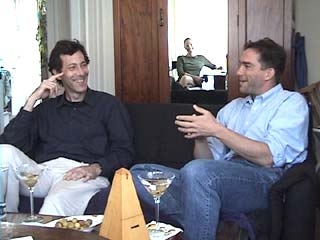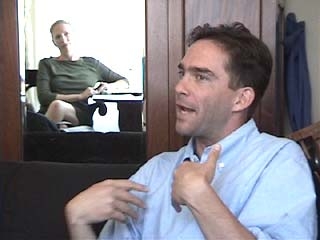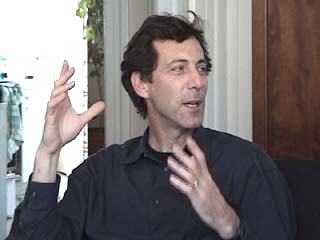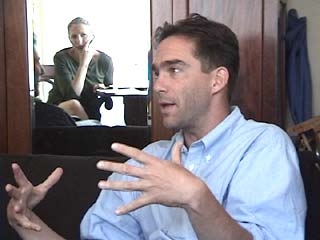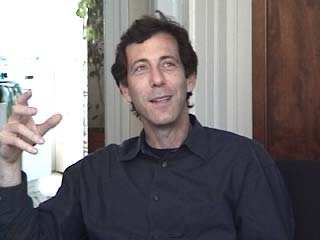Feature: Conversations
Larry Rinder and Ralph Rugoff in Conversation
Part I – Biennials, Half Full or Half Empty? Great and Awful Spaces for Viewing Art
Editors’ note: In September 2000, Stretcher brought Larry Rinder and Ralph Rugoff together for an informal conversation over cocktails and hors oeuvres. The immediate pretext was obvious - Rugoff had just taken the director position formerly held by Rinder at the CCAC Institute. Suprisingly, the two had never met. They relished the opportunity to discuss, face to face, issues pertinent to their incoming and outgoing roles at the CCAC Institute and other curatorial matters and strategies. What followed was a fascinating exchange that highlighted their unique curatorial approaches and musings on future trends in art and culture.
Formerly an independent curator and writer, Rugoff has organized many exhibitions including Scene of the Crime, 1997, at the Armand Hammer Museum and Cultural Center, and The Greenhouse Effect, April - May 2000 at the Serpentine Gallery and the Natural History Museum in London. He is also the author of the groundbreaking Circus Americanus (Verso Books, 1995), a book of essays on contemporary visual culture. Since becoming Director of the CCAC Institute, Rugoff has curated several exhibitions including Tracking, March - May 2001, an exhibition of contemporary video works that employed a specific camera technique - tracking, or dollying - borrowed from the vocabulary of film and reinterpreted in an installation context.
From 1988 to 1997, Rinder served as Curator of 20th Century Art, and, since 1991, Curator of the Museum’s MATRIX Program at the University of California Berkeley Art Museum. There, he organized numerous exhibitions, including In a Different Light with artist Nayland Blake in 1995, an exhibition exploring the resonance of gay and lesbian experience in 20th-century American culture. Rinder became inaugural Director of the CCAC Institute in 1998. He is now Curator at the Whitney Museum in New York where he recently curated BitStreams. Rinder has been named curator of the Whitney’s 2002 biennial.
Stretcher I guess there is a general question to start with - what you each find important, exciting cultural production of the moment; and then there’s another part to that question, but maybe you can just give me a gut take on the big broad question.
Larry Oh boy, that certainly is a big question. Well, I’m focusing right now on a show for the Whitney on the impact of digital technology on contemporary art. I have my face in the middle of that subject. And because the show is coming up in March, I don’t have time to look at much else, so that is what I’m focusing on. And I certainly find that an interesting area. There’s a lot of fantastic work being done but also just the general impact of digital technology across the board, I think is quite extraordinary. I just got back from a trip to Europe where I was looking at exhibitions and exhibition practices and comparing different, particularly large scale exhibitions; Manifesta, the European Biennial and comparing that to the Lyon Biennial, in terms of the Whitney Biennial was provocative. To look at those - if you think of exhibitions as one aspect of cultural production certainly that’s something on my mind.
Stretcher They also have the museum, what is it, ZKM?
LR I went there. Zentrum für Kunst und Medientechnologie, that was really terrible, a god-awful experience. One of the more depressing cultural cul de sacs…
Stretcher …I had it in my mind that it’s considered one of the state of the art institutions!
LR It’s just astonishing how low tech such a high tech place could be and the quality of the materials that are given to the exhibition displays is really meager. And just in general, there’s a feeling in the place of just a lack of sensitivity to aesthetic concerns. Like there’s an exhibition up now about the body and it includes works not only in new media but in other media as well - prints, drawings, photography. For instance, they had this whole wall of photographs including photographs by everyone from Bellmer to Man Ray and so forth. And instead of having actual photographs, they just had Xeroxes of photographs like that was good enough for them. And that kind of typifies what the spirit of that place is. It’s really unfortunate.
Ralph That’s interesting. I once saw a right wing group that had an exhibition for Congress in Washington, of NEA funded projects that they thought should not have been funded, including works by Mapplethorpe, Serrano, Bob Flanagan. And a lot of the work they had was stuff that was Xeroxed or shot off monitors and put on easels, displayed like that. And I thought it was actually a really interesting exhibition concept, that it was so low grade, you almost had no idea what the artwork was. The context was something else. But I wonder what would happen if you did an exhibition that was just based on low - grade copies…
LR degraded… yeah
Stretcher And would copyright infringement even be an issue in that case because the replication was so awful, what percentage could you argue that it was representative of the work that it was trying to represent?
RR Well, yeah, and also you’re turning the exhibit into an exhibition. You’re looking at art works as exhibits, rather than just presenting it in some way that’s supposedly natural without quotation marks around the art. So they’d normally go to exhibitions and those quotation marks are invisible but they do create a distance between you. You go into the museum and you go, ok I know what I’m looking at. This is art and I’m supposed to have a certain kind of experience. And you may not have, you may not spend enough time with the work to get beyond that kind of pre - framed experience that this is a work of art, and I put it in this category and I only have this kind of experience. I am also interested in thinking a lot about exhibition models. Biennials seem to be a model that’s become an epidemic. There were over 12 international biennials last year, I think. So it’s become to some degree, almost like a kind of tourist event. It’s one way countries can generate a certain amount of publicity to get people to come and visit. And I think it’s become increasingly difficult for biennials to try to differentiate themselves from that kind of model and serve a different purpose.
LR Of course, the other way to look at it, is that it’s a massive radical democratization of the art world. People before in Johannesburg, arguably, to play devil’s advocate, didn’t have a chance to see art from all over the world and the fact that (never mind what the grizzly intent behind them might be) there are these huge, international art exhibitions happening all over the world. And people who otherwise wouldn’t have been able to see things, are being able to see them. Now, I’ve heard, (although I haven’t been there myself) Johannesburg, for example, after the week of openings, when all the curators from all over the world were flown in, that nobody went. I have to say that, Manifesta, which I went to in Libliana, was empty. Empty. Even the Lyon Biennial was almost empty when I was there. So there does seem to be this strange, cultural boosterish international art world Mafia mechanism at work that, I think, just can’t sustain itself, really.
RR Yeah, in New York, you’re almost a special case, because so much press is focused on New York. The Whitney Biennial, no matter what happens, people go. Actual people go. They go to see it and talk about it.
LR It is such a blessing! One of the things I’m really grateful about my job is that people will actually go to see the exhibitions that I put on, good or bad.
RR I think this is the problem that actually plagues a lot of museums and regular exhibitions. I noticed a practice in a lot of contemporary art museums to inflate their attendance figures. I know MOCA in LA is guilty of this and most of the times when I’ve been to MOCA it’s completely empty…
LR It’s astonishing.
RR …And I wonder how much of this has to do with the fact that a lot of exhibitions aren’t particularly inviting in terms of creating a space where you want to spend some time. I think the lighting in the last Whitney Biennial…
LR The lighting? Hmm…
RR …was really very different from any biennial I’ve ever been to. It’s more subdued and it was a much more kind of seductive environment as a result. And I think a lot of the painting looked a lot better. I mean I had seen Lisa Yuskavage and John Currin had shown at the Saatchi Collection in London six months before that. The work was really over lit and it looked really bad. I’m not a huge fan of their work but I thought it looked really good at the Biennial.
LR That’s interesting. I think that the environment, the physical environment, and the sensorial environment that you put work in, it makes a big difference. For example, ZKM and the gallery next to it, the Neue Gallery, are two of the most hideous spaces for art viewing that I’ve ever seen in my life. Just these cavernous spaces, I don’t know what they were thinking when they built those places. But in this Neue Gallery, which is like the contemporary modern art museum of Karlsruhe, it was really frightening. The guards there hide in these little dark corners. They actually have these little places for them to put themselves. And every now and then you see one and it’s frightening. It’s like, they’re buried alive! Because they’re the only other people you see there.
In contrast, I went to another techie exhibition in Dortmund, which was installed in a former, I think it was a former power plant or steel mill or something like that. First of all, it was a fascinating space, physically. It was a 19th century industrial campus, basically. Overdone, made to look like a villa or chateau, so that the workers, as they’re going to work, feel like they’re going to the manor. And you go inside these buildings that look like a chateau and there’s these huge turbines and everything. And they had underlit it to the point where almost the only light in there was coming from the works themselves, so it created this wonderful, cavernous, corpuscular environment and the choice of the works wasn’t that much better than what was at Karlsruhe. It was simply because of the beauty of the space, the sensitivity of the installation, the creativity of the installation. You really wanted to be there. And Dortmund, it wasn’t even in Dortmund which is out of the way itself, it was in some little, like, nowhere place that you had to take a little train to get to it and then get off and then the train would just stop in the middle of some blueberries and you get off and crawl through and find this place. And that was full of people. It was full of really interesting looking young people, who were happy to be there.
RR Interesting. When you were in Europe, there was a show in Paris - Voila. Voila was dealing with archives. And so there was a lot of work that was actually computer stations. And Bruce Mau for instance, had a site where you could scroll through a thousand images he had curated from online auction sites, objects, displays of objects, precious things. I think it was actually called Love Moans or something like that.
LR I didn’t see that.
RR No, you wouldn’t want to see it. I wouldn’t want to see it because I feel like this is the kind of thing I can do at home. I mean, I hate the idea of going to a museum and sitting down at a computer, which is a very private experience, because for me, when I get excited about being in a museum it’s because it is a public space. There are certain kinds of experiences you have in that space that are really different from sitting down in front of a computer.
LR I don’t have quite such a black and white view of it. I think that it’s intriguing to think about computer perception or that art experience on a computer, in a museum context. It’s different from what one has at home but it’s different precisely because it is in a social space and can be seen in a historical continuum with other objects which, if you’re looking at it at home, you can’t get. You can argue by the same token that any bourgeois art object is best viewed at home in the comfort of your living room. And it’s alienated in a museum context.
RYes, but we usually don’t have access to all those art objects, whereas we can access this stuff on the Internet. I mean it made me think, five years ago, I attended a conference in Germany that was on the Museum in the Age of the Electronic Collection. And it was a bunch of museums that were terrified of the idea that all archives were now going to be on the Internet. And what was going to happen to the museum? Were people actually going to go to museums anymore when they can look at all this stuff at home?
LR They were actually worried about that?
RR So many museums had a knee-jerk response to the Internet. They wanted to get their websites out, and they didn’t really do anything with the website, it was just basic documentation of what was in the museum. But there is a funny sense in which the computer does seem like this very powerful miniature museum in that it can collect all these images. It doesn’t have the space that the museum has and to me that’s a big difference.
LR The physical space?
RR …The physical space and the fact that it can be occupied by visitors.
LR But they can. Have you been to Active Worlds? It’s an interactive site. There’s a whole art world. You have an avatar-Active Worlds is the generic word for this 3D interactive software. And then different people have built different worlds. There’s Hungarian Fisherman’s World and there’s also something called Art World. And different museums have hired architects like asymptote to build museums and there’s actually a place with addresses where you can go. You can go into these buildings with your avatar and meet other avatars from elsewhere and there’s openings and there’s - you can buy shit.
Stretcher It’s all virtual.
LR Yes, and the first stage of this of course is just scanning images of photographs or paintings and just sticking them on the walls of these museums. The second stage, which will happen slowly but in parallel, is works created for those spaces. Digital works. And yeah, it’s happening; we’re deeply into it.
Stretcher So did you find currently speaking that Europe had progressed since your last visit in terms of their openness to that technology and their facility with it?
LR Well, they’re not only open to it, they’re obsessed with it. Europeans are head over heels, I mean, not all of them but much more- in general, I feel that in Europe- Eastern Europe, Western Europe- there’s more, across the board, institutional interest in technology or art using technology. Not always in the context of traditional museums. I mean, often, new institutions, like ZKM, have to grow up to accommodate this, but there are, I feel and am pretty certain, that there are more institutions in Europe focusing on this kind of thing than in the United States. It’s amazing that in the Bay Area, there isn’t a single organization that I can think of that focuses on this-just a museum of techie art. You would think there would be something like that here.
Stretcher So Ralph, you never answered my question.
RR Cultural production? I think maybe this is sort of a non-answer, but it’s just that there is no specific thing and I think that’s something that has been going on for a while, that it’s continued is kind of interesting. But there’s so many different pockets of cultural production, completely unrelated. I mean, there’s a new interest say in a kind of activist art that’s very different from say, the work of the 60’s and 70’s that was activist art. And I see probably more in Europe than in the US. And it’s very theoretical. I mean it’s people who realize they’re not gonna change the world. But I think somehow the idea of utopia- which was sort of put in prison for a long time, as a retrogressive idea leading to things like Nazi Germany- has come back. And I think a lot of artists are interested in utopia and ideals again.
Stretcher So this is a cynicism backlash?
RR Yeah, maybe it is a cynicism backlash. Which may not be a good thing because all backlashes are sort of dead ends. But I think it’s nice to take something out of the closet again but see if we could re-examine it and turn this into a constructive concept, provided we’re not true believers. So that maybe there’s an idea of a problematic Utopia that’s starting to circulate again.
LR Are you thinking about people like the Danish activist collectives?
RR Some of the Swedish architectural firms like Superflex or N55 that have done things like have built housing modules for housing in Africa. But they’re also very intent on exhibiting these things as works of art in the art context. Niels Norman makes little models of various kinds of social interventions that are possible, and he does it sort of like a railroad model scale.
Stretcher they’re little prototypes?
RR They’re prototypes and it might be a prototype of a political demonstration, how to organize it so that the police can’t break it up; he’s done a lot of kinds of work. On the down side of it, there’s a lot of work that involves, say, working with some segment of "the community" - people in housing projects - and making interminable videos about this thing and you feel, like, I’m really glad this artist went and spent this time with this person, but I don’t want to watch the three hour video.
Click here for Part II – The Blur between Art and Design

